Volkswagen Passat (2011-2015) Review
Written by Andrew Brady
Quick overview
Pros
- Premium and understated image
- Comfortable and well-made cabin
- Excellent range of engines and trim levels
Cons
- Dull and uninspiring to drive
- Anonymous styling
- The Ford Mondeo offers better value for money
Overall verdict on the Volkswagen Passat
"In this Volkswagen Passat review we are looking at a saloon that is as straight-laced and sober as they come. The Passat is understated, smooth, comfortable and classy, it just also happens to be flair-free, a bit dull and positively yawnsome to drive. But that won't matter to everyone, and so as a used purchase it might just be exactly what you're looking for."
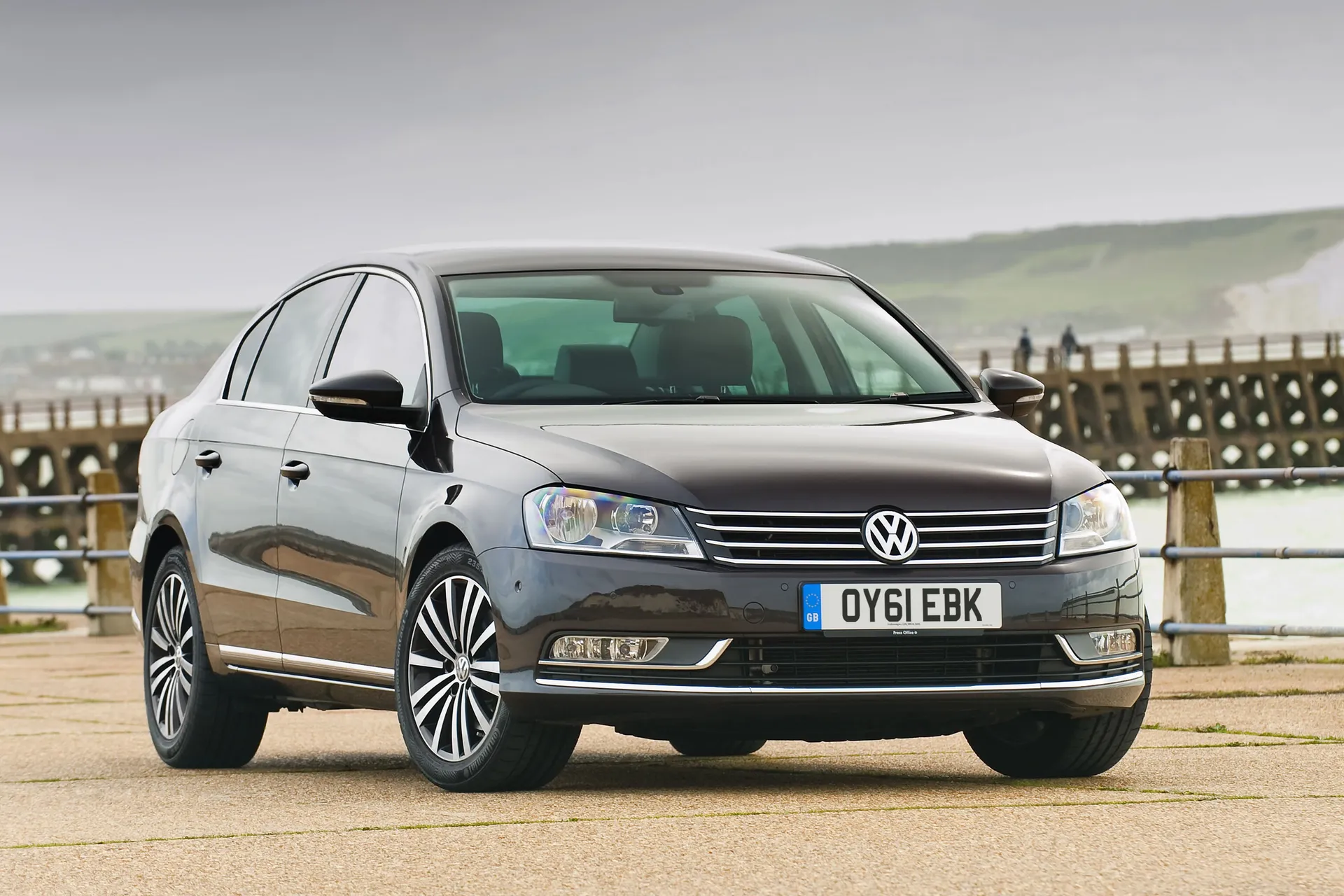
Few markets are as competitive as the compact premium sector. It’s a tricky type of car to get right, with buyers demanding brilliant motorway manners, space for the family, excellent safety credentials and enough gadgets to satisfy the most tech-hungry nerd.
To this end, the Volkswagen Passat is a fine choice. Available as a saloon or estate, the Passat offers understated styling, a classy cabin, plenty of space and a range of efficient and punchy engines. There’s even an Alltrack variant, if you haven’t bought into the SUV craze.
Although Volkswagen claims the Passat can seat five, it would be best to describe it as a spacious four-seater. That’s because the middle rear seat is hampered by a wide transmission tunnel, meaning there’s nowhere for the passenger to put their feet. This is a minor complaint, because the other seats benefit from plenty of headroom and legroom.
Predictably, the estate is the Volkswagen Passat to choose if you’re after the most space and flexibility. The boot is cavernous, while the rear seats fold flat for those trips to Swedish furniture stores. Not that the saloon is lacking space – it just can’t match the estate for versatility.
The cabin itself is finished to a very high standard, with the buttons and switches offering a reassuring level of quality. Some of the plastics used for the bottom half of the interior feel a bit cheap, but this is true for many of the Volkswagen Passat’s rivals.
Aside from the entry-level version, all models offer a generous level of standard equipment, although an infotainment system is optional on many trim levels. The same is true of leather seats, but this is a minor gripe.
On the road, it’s clear the Volkswagen Passat was designed for covering long distances in supreme comfort. Ride quality is excellent, with the Passat offering premium levels of comfort and refinement. There’s virtually no wind noise, while road roar is suppressed by excellent soundproofing.
Things start to unravel if you attempt to take a corner with vigour. The numb steering is overly assisted, while the chassis will cry for help if you’re too enthusiastic through a bend. You need to adopt a smooth and measured approach to get the best out of a Volkswagen Passat.
We’d be tempted to opt for the Alltrack estate. Thanks to a four-wheel-drive system, a raised ride height and extra ground clearance, the Volkswagen Passat Alltrack offers excellent off-road qualities, which makes it a credible alternative to the modern SUV. It’s also more comfortable on the road, which lends it a more premium feel.
Overall, the Volkswagen Passat is a car you buy with your head and not your heart. The understated styling is bordering on dull, the cabin lacks flair, and the driving experience is forgettable. However, for low running costs and a comfortable ride, the Passat is hard to beat.
If you're looking for the newer version, you need our Volkswagen Passat review.
Is the Volkswagen Passat right for you?
The Volkswagen Passat bridges the gap between the volume brands and the premium manufacturers, offering a classy and upmarket feel.
It’s not the least bit exciting, but thanks to a wide range of engines and trim levels, not to mention three body styles, you’ll almost certainly find a Volkswagen Passat that’s right for you.
Highlights include a smart cabin and loads of space, along with smooth and comfortable motorway manners. The engines are another plus point, with each one offering a terrific blend of performance and economy.
Although Volkswagen did its best to convince us this was a new model, it’s best to think of the Mk7 Passat as a comprehensive revamp of the Mk6 model. Not that this matters, because it represented a big step up anyway.
What’s the best Volkswagen Passat model/engine to choose?
The 2.0-litre TDI 140PS diesel is an excellent all-rounder, offering more torque and power than the 1.6-litre TDI, with only a small penalty in terms of fuel economy. From a tax and fuel perspective, it should be no more expensive to run than the 1.6 engine.
We’d recommend the estate over the saloon. Subjectively, the estate looks classier, and there’s no difference between the two on the used market. There will come a point when you’ll be glad you chose the more practical version.
The S trim is a bit basic, so we’d opt for the SE/Highline model. It offers the kind of toys you’ll need to while away the hours on a long motorway journey. The Alltrack is worth a look if you need a car with genuine off-road ability. It’s more practical and better to drive than the vast majority of SUVs.
What other cars are similar to the Volkswagen Passat?
The Ford Mondeo and BMW 3 Series are the two cars that spring to mind, not least because the Volkswagen Passat falls somewhere between the two. While it’s not as nice to drive as the Mondeo or 3 Series, it’s classier than the Ford, with an upmarket feel that edges it close to the BMW.
Other rivals include the Vauxhall Insignia, Volvo V60 and Mercedes-Benz C-Class. If you’re in a Volkswagen showroom, the Volkswagen Tiguan will be the rival hoping to tempt you out of the Passat saloon or estate.
Comfort and design: Volkswagen Passat interior
"If you thought the outside of the Volkswagen Passat was predictable, just wait until you see the inside. The design of the dashboard is utterly conventional, while the layout of the major controls is pretty much as you’d expect. No flair, nothing fancy, just very… German."
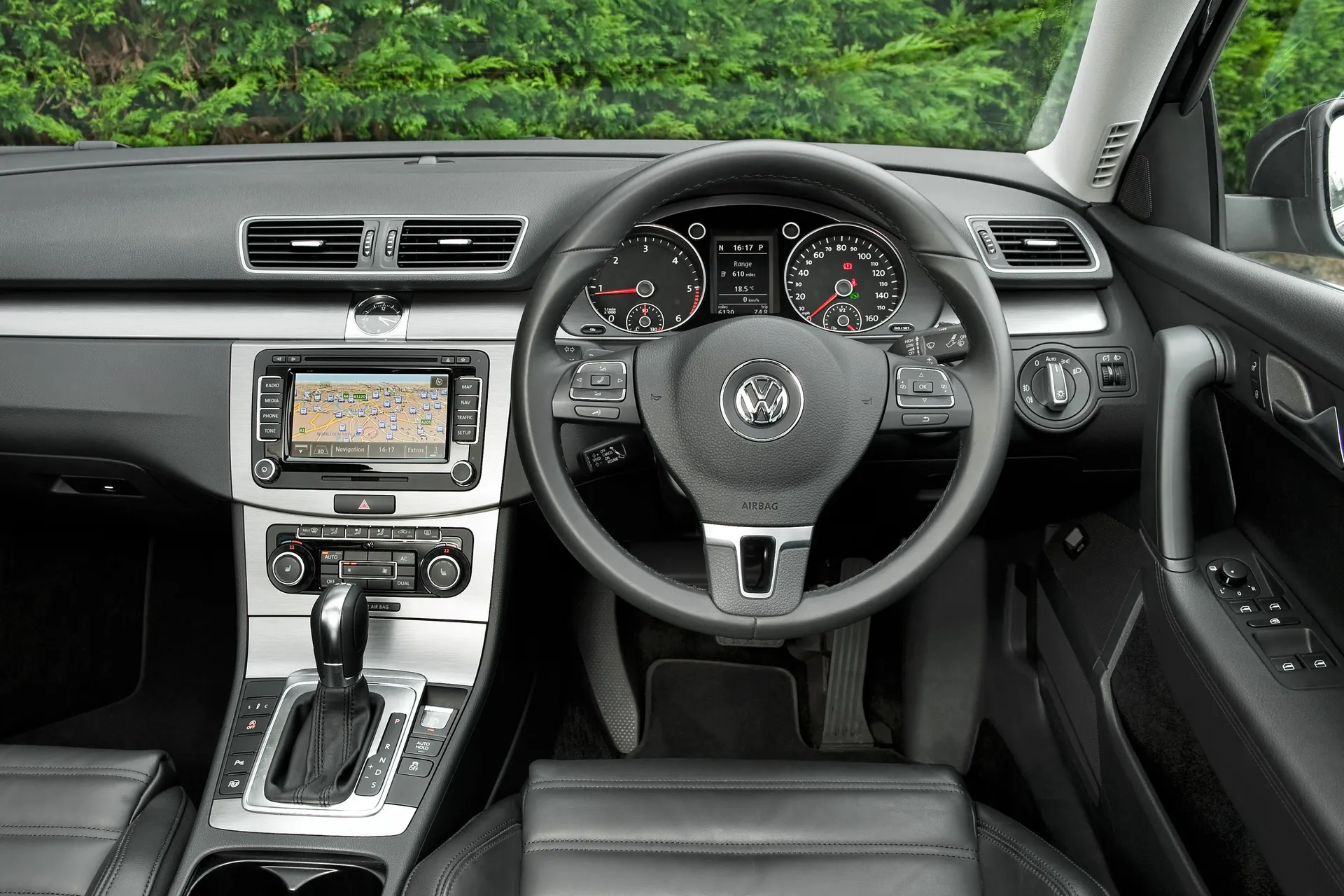
There’s nothing wrong with that. Cars like the Volkswagen Passat are designed to be easy to live with and comfortable on long journeys. You should arrive at your destination feeling no more stressed than having sat in your favourite armchair for a couple of hours. In this respect, the Volkswagen Passat is a class leader.
All versions get air conditioning, a steering wheel adjustable for reach and rake, along with height adjustable front seats. However, upgrading to SE trim adds front comfort seats with height and lumbar adjustment on the passenger side, plus electric six-way adjustment and lumbar support for the driver.
This alone would make the SE (later the Highline) superior to the S, but you also get cruise control, an auto-dimming rear-view mirror and a rain sensor. These all combine to create a more comfortable driving experience.
Upgrading to Sport adds dual-zone climate control to the mix, along with more supportive sports seats and lowered suspension. This sacrifices a degree of comfort for handling, but the Sport also features adaptive chassis control, which allows you to select different driving modes.
In truth, there’s not a huge amount of difference between Normal, Comfort and Sport, although the Comfort mode does restore some of the Volkswagen Passat’s inherently excellent ride quality.
Quality and finish
You’ll struggle to find anything wrong with the fit and finish of the Volkswagen Passat. The doors shut with a reassuring thud, while the interior is finished to the level of quality you’d expect from a German family car. It’s not quite Audi standard, but it comes very close.
The ‘floating’ dashboard design lends the cabin a touch of class, while the major controls and switches operate with precision and firmness. It speaks volumes that the Volkswagen Passat feels like a quality car, even in its most basic form.
‘Vienna’ leather was optional on all trim levels at launch, with perforated climate seats and Nappa leather also available. In January 2014, Volkswagen introduced the Executive and Executive Style trim levels. These cars featured leather seats as standard, along with a host of desirable options and accessories.
The Executive Style edges the Volkswagen Passat into premium territory, with bi-xenon headlights and heat-insulating rear glass.
In many ways, the Volkswagen Passat Alltrack feels like the most premium model in the range. The raised ride height delivers greater levels of comfort, while the cloth and Alcantara seats feel a class above the standard items.
Infotainment: Touchscreen, USB, nav and stereo in the Volkswagen Passat
This generation of Volkswagen Passat takes us back to a time when touchscreen infotainment systems were the preserve of top trim levels and premium cars. As such, some versions of the Passat ‘make do’ with a basic DAB digital radio receiver, Bluetooth connectivity, a CD player and an aux-in socket.
At launch, the flagship version featured a five-inch touchscreen display with satellite navigation, an SD card reader, CD player and an aux-in socket. It’s a primitive system by today’s standards, but offers a refreshing level of simplicity that is absent from today’s complex infotainment setups.
Things improved before the end of production, but basic models still lacked a touchscreen of any kind. There were three screens available: a 6.5-inch touchscreen with DAB digital radio, an aux-in socket and six CD autochanger; a five-inch touchscreen with DAB, aux-in and satellite navigation; and a 6.5-inch touchscreen with DVD navigation, voice control and a rear-view camera.
Predictably, given the age of the car, Apple CarPlay and Android Auto connectivity aren’t available.
Space and practicality: Volkswagen Passat boot space
The Volkswagen Passat estate is the version to go for if you’re after maximum space and practicality, but don’t be too quick to dismiss the saloon. The boot in the four-door Volkswagen Passat offers a generous 565 litres of luggage space, with the option of carrying longer loads by folding the rear seats.
With the rear seats in place, the Volkswagen Passat estate offers a generous 603 litres of space, but this increases to 1,731 litres with the rear chairs folded down. The Alltrack estate is less practical, with the four-wheel-drive system robbing it of 15 litres of luggage capacity. We doubt you’ll notice those missing litres.
Extra convenience is offered via the hands-free boot opening, which uses a foot sensor to open the boot or tailgate. Simply wave your shoe under the bumper to open the boot. Although this technology is relatively common today, it was quite a novelty at the Volkswagen Passat’s launch in 2011.
In the estate, the 60/40-split folding rear seats create a perfectly flat floor, while the optional sliding load bed makes it easy to shift heavy items from the back to the front of the boot. It’s another neat touch.
Although Volkswagen claims that the Passat is a five-seater, we’d argue that it works best as a four-seater. Space for the middle seat passenger is restricted by the wide transmission tunnel, so there’s nowhere to put your legs. If you’re driving, your rear-view mirror will be filled with the face of a passenger begging for mercy.
Elsewhere, there’s enough headroom and legroom for four adults, so there’s plenty of growing room for your children. The roofline in the estate provides more headroom, while the extra glass creates a lighter and more airy cabin.
The central storage bin is huge, the glovebox is of a good size and the door pockets are big enough for a large bottle of water, plus there are plenty of other useful storage areas dotted throughout the cabin.
The Volkswagen Passat dimensions are 4769mm long, 1820m wide and 1470mm tall.
Handling and ride quality: What is the Volkswagen Passat like to drive?
"The Volkswagen Passat majors on comfort. It’s a car designed for the long motorways of Europe, where it feels perfectly at home with cruise control engaged, a coffee in one of the cupholders and the climate control temperature set to ‘just so’."
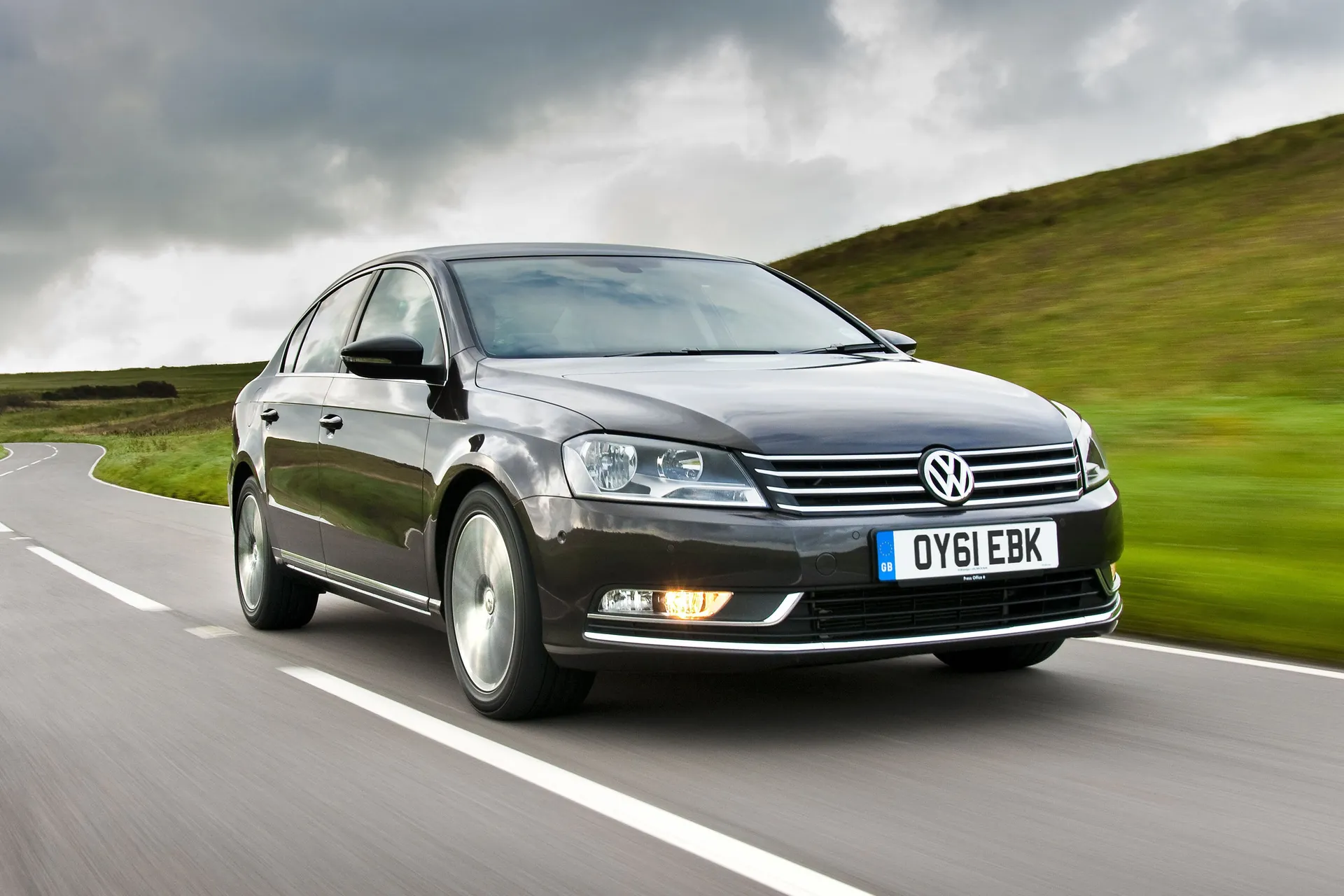
It’s a supremely comfortable car, with suspension that soaks up all but the worst imperfections in the road. Although lowered suspension is available on some models, we’d question the need for this, as it shifts the Volkswagen Passat away from its core appeal. We’d also avoid the adaptive chassis control, as there isn’t a noticeable difference between the three settings.
For the best ride comfort, stick with the 16- or 17-inch alloy wheels. Although the ride quality is by no means terrible on 18-inch rims, you lose some of the Volkswagen Passat’s cosetting qualities. On motorways and major roads, the Volkswagen Passat offers premium levels of smoothness.
Things start to go awry if you attempt to corner with any enthusiasm. The steering is numb and devoid of feel, which is the first thing you’ll notice. There’s also a general heaviness to the way it handles. It just feels a bit cumbersome and out of its comfort zone.
Although it’s more expensive and harder to find, the Volkswagen Passat Alltrack is the best of the bunch. The raised ride height makes it feel even more cushioned on the road, while the four-wheel-drive system and extra ground clearance mean you can venture off the beaten track.
The Alltrack isn’t a true rival to a four-wheel-drive SUV, but for rutted tracks and grassy fields, it’s just the job. It also comes with a decent level of standard equipment, making it a cut-price version of the Audi A4 Allroad.
What engines and gearboxes are available in the Volkswagen Passat?
The Volkswagen Passat comes with a wide range of engines, but the diesel units have always been the pick of the crop. Our choice would be the 140PS 2.0-litre TDI unit, which is available with a six-speed manual gearbox or Volkswagen’s familiar DSG automatic transmission.
It boasts a top speed of 131mph and a 0-62mph time of 9.8 seconds. The 170PS version of the same engine will complete the 0-62mph dash in 8.6 seconds, before hitting a top speed of 141mph with a manual gearbox, or 139mph with the DSG.
A 105PS 1.6-litre TDI is also available, but it feels a little off-the-pace, especially when travelling with four people and their luggage. You’ll have given up long before the 12.2 seconds it takes to reach 62mph.
Of the petrol engines, we’d choose the 122PS 1.4-litre TSI for its blend of performance and efficiency. The 0-62mph time is a respectable 10.3 seconds, while top speed is 127mph.
The 160PS 1.8-litre TSI is an excellent engine, offering a top speed of 137mph and a 0-62mph time of 8.5 seconds. At the top of the range, the 210PS 2.0-litre TSI feels rather rapid, as highlighted by the 0-62mph time of 7.6 seconds and the top speed of 148mph. It was paired with the old Sport trim, so it’s the closest the Volkswagen Passat gets to a true driver’s car.
Refinement and noise levels
The Volkswagen Passat offers exceptional levels of refinement, helped by a generous amount of soundproofing and noise control. There’s virtually no wind noise, with only a light whistling noise when you reach motorway speeds.
Because the 1.6-litre TDI engine is a little underpowered, it has to be worked hard to get the best from it. As a result, it can sound a little coarse when accelerating, and noisier at motorway speeds.
The other units are more refined, with each one offering smooth and relaxed performance. For the best results, opt for the DSG transmission, which is available on all except the 1.6-litre TDI model.
Although it can be a little slow to change and hesitant at low speeds, the shifts through the gears are seamless once up to speed. You’ll hardly notice the shifts, but if you require more control, manual changes are available. This is useful on the Alltrack model, especially when driving off-road.
Safety equipment: How safe is the Volkswagen Passat?
The Volkswagen Passat was awarded a maximum five-star Euro NCAP safety rating in 2010. The individual scores were 91 percent for adult occupant protection, 77 percent for child occupant protection, 54 percent for pedestrian safety, and 71 percent for safety assist systems.
At launch, all models came fitted with stability control, driver and front passenger airbags, front seat side impact airbags, curtain airbags and daytime running lights. Other models got cruise control with driver fatigue detection, a flat-tyre indicator and rain-sensing wipers. A city emergency braking function was available as an option.
Lane assist could be fitted in lieu of the fatigue detection system, while bi-xenon headlights were also optional on all models.
While the Volkswagen Passat lacks some of the driver assistance systems fitted to modern cars, it remains a solid and safe vehicle. This is especially true of the Alltrack model, with the four-wheel-drive system offering excellent all-weather and all-season performance.
MPG and fuel costs: What does a Volkswagen Passat cost to run?
"Although the official figures were sourced using the less reliable NEDC test system, the Volkswagen Passat delivers excellent fuel economy. This is especially true of the diesel models."
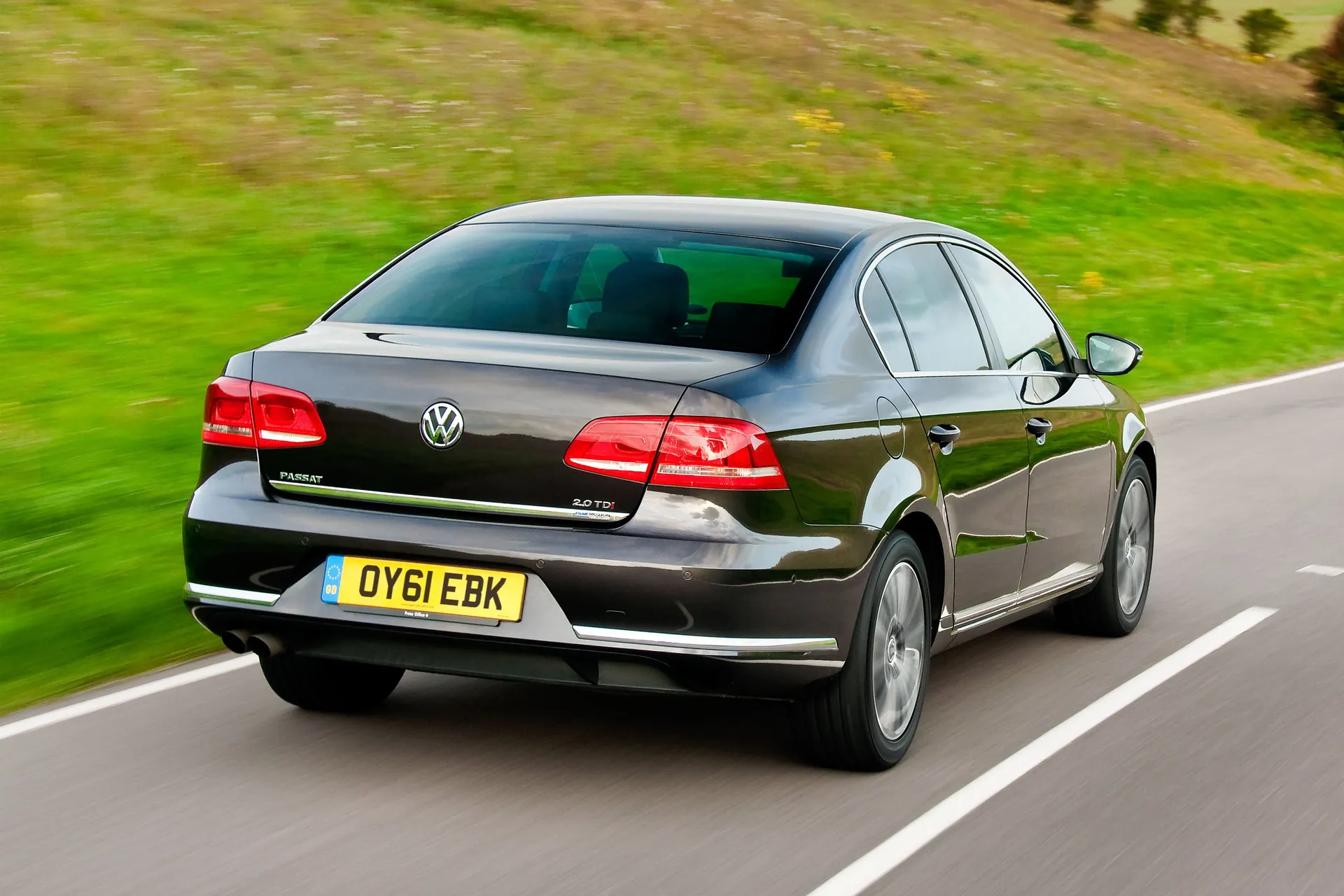
At launch, the 1.6-litre TDI 105PS with a manual gearbox offered a claimed 65.7mpg on a combined cycle. The 2.0-litre TDI 140PS managed a claimed 61.4mpg with a manual gearbox, or 54.3mpg with the DSG transmission.
There’s not a huge penalty for choosing the 170PS version of the 2.0-litre TDI diesel, with a claimed 61.4mpg possible. Of the petrol versions, the 1.4-litre TSI offers the best economy, with a figure of 47.1mpg. These figures are based on the Passat saloon.
How reliable is a Volkswagen Passat?
The Volkswagen Passat scored a lowly 8.75 out of 10 for reliability in the HonestJohn.co.uk Satisfaction Survey, which makes it one of the worst-performing Volkswagens and puts it behind some key rivals.
As a brand Volkswagen did a bit better, finishing 10th overall out of 30 manufacturers.
Insurance groups and costs
With an insurance group rating of 16, a Passat saloon with a 1.6-litre TDI engine will be the cheapest to insure. Other models range from 17 to 26. Even the 1.4-litre TSI R Line should be relatively inexpensive to insure, thanks to a group rating of 24.
The Passat estate has similar insurance group ratings to the saloon.
You’ll pay more to insure the Passat Alltrack, with the off-road wagon in groups 21 to 26. For some context, the Skoda Octavia Scout (2007-2012) slots into groups 16 to 20.
VED car tax: What is the annual road tax on a Volkswagen Passat?
The rate of Vehicle Excise Duty (VED, or road tax) varies according to CO2 emissions. Of the launch cars, the Volkswagen Passat 1.6-litre TDI 105PS emits the least CO2, with figures of 114g/km and 116g/km. This means you’ll pay just £30 a year in VED.
The 140PS version of the 2.0-litre TDI also creeps into this tax band, as does the 170PS version of the saloon. The Passat estate with the 170PS engine emits 123g/km of CO2, so the rate goes up to £125.
Other models are more expensive, including the 2.0-litre TSI petrol, which costs £240 a year in VED.
How much should you be paying for a used Volkswagen Passat?
"Prices start from less than £3,000, but for this budget you’ll be looking at Volkswagen Passat saloon or estate with around 150,000 miles on the clock and more than a few battle scars."
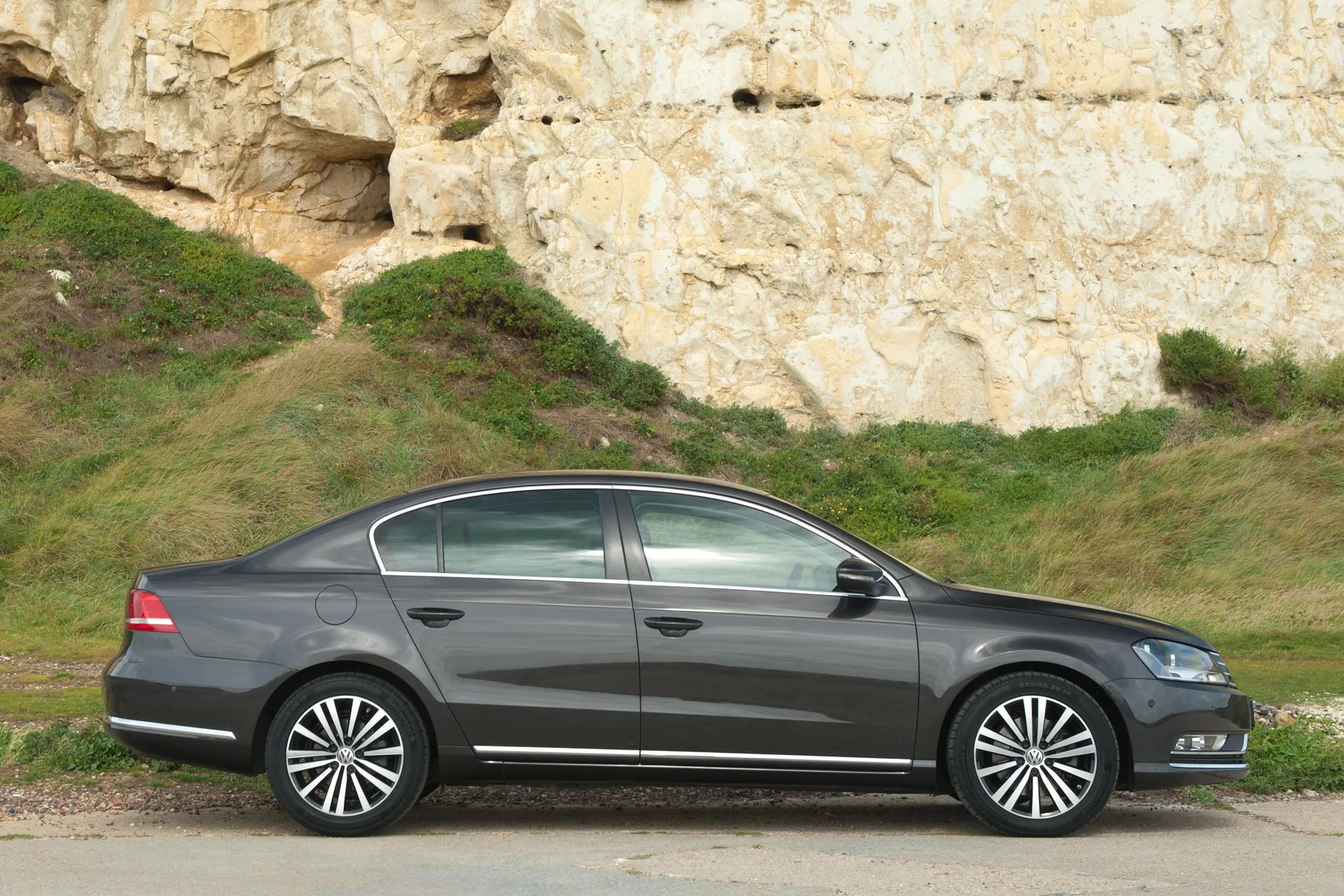
Finding a Volkswagen Passat Alltrack will be trickier and you’ll need to find at least £7,000 for one of the earliest examples. One thing you’ll discover is that used Volkswagen Passats of all ages tend to have a lot of miles on the clock. This is because many of them were bought as company cars to pound the nation’s motorways.
The most you’ll pay for a Volkswagen Passat of this era is £16,000. For this budget, you’ll get a high-specification car in R-Line trim. Some of the cars are available via Volkswagen’s approved used car scheme.
Trim levels and standard equipment
The Volkswagen Passat launched with a choice of three trim levels: S, SE and Sport. Highline trim replaced the SE model in October 2012, with R-Line joining the range in May 2013. Executive and Executive Style arrived in January 2014. The other variants are the frugal BlueMotion and the Alltrack off-roader.
We’d avoid the Volkswagen Passat S trim. Although it comes with air conditioning, 16-inch alloy wheels, a radio and CD player, the spec feels a bit miserly in 2020. The Volkswagen Passat SE trim adds arch-filling 17-inch alloy wheels, cruise control, chrome detailing, electric adjustment for the seat and an auto-dimming rear-view mirror to make the ownership experience a little more special.
Although the Volkswagen Passat Sport packed a decent level of equipment, we’d recommend the later Volkswagen Passat Executive trim. Highlights include leather seats, a five-inch touchscreen display, DAB digital radio, satellite navigation, parking sensors, dual-zone climate control, 17-inch alloy wheels and electric seats. The Volkswagen Passat Executive Style adds bi-xenon headlights, 18-inch alloys, front fog lights with cornering function and heat insulating tinted rear glass.
Ask the heycar experts: common questions
Are Volkswagen Passat's good cars?
Why is the Volkswagen Passat discontinued?
Is a Volkswagen Passat like an Audi?
Get our latest advice, news and offers
Keep me updated by email with the latest advice, news and offers from heycar.
By submitting you agree to our privacy policy


